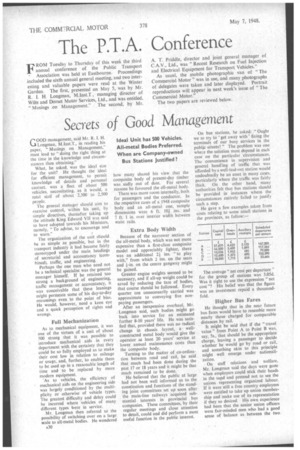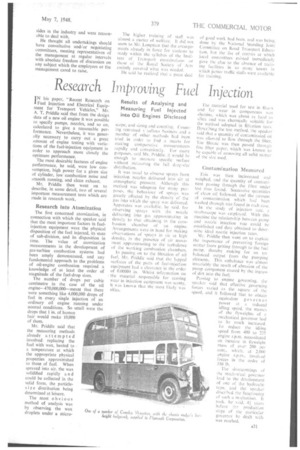Secrets of Good Management
Page 32

Page 33

If you've noticed an error in this article please click here to report it so we can fix it.
GOOD management, said Mr. R. 1. H. Longman, M.Inst.T., in reading his paper, "Musings on Management," must lead to "doing the right thing at the time in the knowledge and circumstances then obtaining."
What, he asked, was the ideal size for the unit? He thought the ideal for efficient management, to permit knowledge of details and personal contact, was a fleet of about 500 vehicles, necessitating. as it would, a total staff of .about 2,300 to 2,500 people.
The general manager should aim to exercise control, within his unit, by simple directives, thereafter taking up the attitude King Edward VII was said to have adopted towards his Ministers, namely, "To advise, to encourage and to warn."
The organization of the unit should he as simple as possible, but in the transport industry it had become fairly stereotyped under the main headings of secretarial and accountancy (combined), traffic, and engineering.
Perhaps the one man who need not be a technical specialist was the general manager himself. If he retained too strong a background of engineering, traffic management or accountancy, it was conceivable that these leanings might permeate some of his day-to-day reasonings even to the point of bias. He would, however, need a keen eye and a quick perception of rights and wrongs.
Full Mechanization
As to mechanical equipment, it was one of the virtues of a unit of about 300 strong that it was possible to introduce mechanical aids in every department with the certainty that they could be so fully employed as to make their cost low in relation to mileage or usage, and, further, to enable them to be used up in a reasonable length of time and to be replaced by more modern equipment.
As to vehicles, the efficiency of mechanical aids on the engineering side was largely conditioned by the multiplicity or otherwise of vehicle types. The greatest difficulty and delay could he incurred where vehicles of many different types vere in service.
Mr. Longman then referred to the possibility of switching over on a large scale to all-metal bodies. He wondered A30
how many shared his view that the composite body of present-day timber was sadly out of date. For several reasons he favoured the all-metal body.
There was more room internally, both for passengers and the conductor. In the respective cases of a 1948 composite body and an all-metal one, sample dimensions were 6 ft. 101 ins. and 7 ft. 1 in. over interior width between Waist rails.
Extra Body Width Because of the narrower section of the all-metal body, which was not more expensive than a first-class composite model and appreciably lighter, there was an additional 2 ins. "to play with," from which 2 ins, on the seats and •j-in. on the centre gangway might be gained.
Greater engine weights seemed to be necessary, and if all-up weight could be saved by reducing the tare of bodies, that course should be followed. Every quarter ton unnecessarily carried was approximate to conveying five nonpaying passengers.
After an inexpensive overhaul, Mr. Longman said, such bodies might go back into service• for an estimated further 8-10 years' life. He was satisfied that, provided there was no radical change in chassis layout, a wellconstructed metal body would give the operator at least 20 years' service at lower annual maintenance costs than the composite body.
Turning to the matter of co-ordination between road and rail, he said that much had been done during the past 17 or 18 years and it might be that much remained to be done.
He believed that the public at large had not been well informed as to the constitution and functions of the standing joint committees set up soon after the main-line railways acquired substantial interests in provincial bus companies. These committees, by their regular meetings and close attention to detail, could and did perform a most useful function in the public interest. On bus stations, he asked: " Ought we to try to 'get away with' fixing the terminals of our busy services in the public streets?" The problem was one where the solution must depend in each case on the particular circumstances, The convenience in supervision and general handing of traffic that was afforded by a well-laid-out station would undoubtedly be an asset in many cases, particularly where the traffic was fairly thick. On the other hand, many authorit;es felt that bus stations should be provided in instances where the circumstances entirely failed to justify such a step, He gave a few examples taken from costs relating to some small stations in the provinces, as follow:—
The average "net cost per departure' for the group of stations was 3.05d. Was it right to use the expression "net cost "? His belief was that the figure was an investment repaid a thousandfold.
Higher Bus Fares
He thought that in the near future bus fares would have to resemble more nearly those charged for comparable distances by rail.
It might be said that if the " travel value" from Point A to Point B was, say, 5s., that should be the appropriate charge, leaving a passenger to decide whether he would go by road or rail, and something akin to this principle might well emerge under nationalization.
On staff relations and welfare, Mr. Longman said the days were glade when employers could stick their heads in the sand and pretend not to see the unions representing organized labour. If it were still a free country employees were entitled to take up union membership and make use of its representation if they so desired. His own experience had been that the senior union officers were fair-minded men who had a good sense of balance as between the two, sides in the industry and were reasonable to deal with.
He thought all undertakings should have consultative and/or negotiating committees, meeting representatives of the management at regular intervals with absolute freedom of discussion on any subject which the employees or the management cared to raise.
The higher training of staff was almost a matter of welfare. It did not seem to Mr. Loncman that the arrangements already in force for students to study within the syllabus of the 'Institute of 'transport examinations or those of the Royal Society of Arts entirely covered what was needed.
lie said he realized that a great deal
of good work had been. and was being, done by the National Standing Joint Committee on Road Transport Education. but the list of centres at which local committees existed immediately gave the clue to the absence of training facilities in so many towns in which junior traffic staffs were available for training.












































































